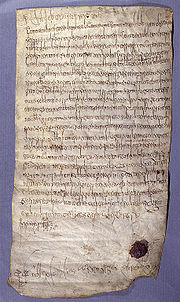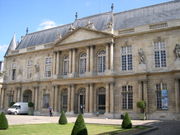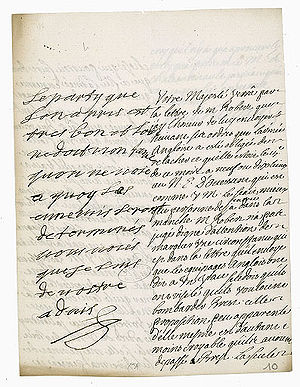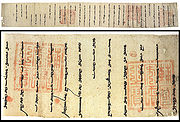
Archives nationales (France)
Encyclopedia

French language
French is a Romance language spoken as a first language in France, the Romandy region in Switzerland, Wallonia and Brussels in Belgium, Monaco, the regions of Quebec and Acadia in Canada, and by various communities elsewhere. Second-language speakers of French are distributed throughout many parts...
for "National Archives") preserve the national archives of the French state
France
The French Republic , The French Republic , The French Republic , (commonly known as France , is a unitary semi-presidential republic in Western Europe with several overseas territories and islands located on other continents and in the Indian, Pacific, and Atlantic oceans. Metropolitan France...
, apart from the archives of the Ministry of Defence and the Ministry of Foreign Affairs
Minister of Foreign Affairs (France)
Ministry of Foreign and European Affairs ), is France's foreign affairs ministry, with the headquarters located on the Quai d'Orsay in Paris close to the National Assembly of France. The Minister of Foreign and European Affairs in the government of France is the cabinet minister responsible for...
, as these two ministries have their own archive services, the Service historique de la défense and the Archives diplomatiques respectively. The Archives nationales have one of the largest and most important archival collections in the world, a testimony to the very ancient nature of the French state which has been in existence for more than eleven centuries already.
The Archives nationales were created at the time of the French Revolution
French Revolution
The French Revolution , sometimes distinguished as the 'Great French Revolution' , was a period of radical social and political upheaval in France and Europe. The absolute monarchy that had ruled France for centuries collapsed in three years...
in 1790, but it was a state decree of 1794 that made it mandatory to centralize all the pre-French Revolution private and public archives seized by the revolutionaries, completed by a law passed in 1796 which created departmental archives (archives départementales) in the départements of France to alleviate the burden on the Archives nationales in Paris, thus creating the collections of the Archives nationales as we know them today. In 1800 the Archives nationales became an autonomous body of the French state. Today, they contain about 406 km. (252miles) of documents (the total length of occupied shelves put next to each other), an enormous mass of documents growing every year. The original documents stored by the Archives nationales range from AD 625 to today.
The Archives nationales are under the authority of the French Archives Administration (Service interministériel des Archives de France) in the Ministry of Culture
Minister of Culture (France)
The Minister of Culture is, in the Government of France, the cabinet member in charge of national museums and monuments; promoting and protecting the arts in France and abroad; and managing the national archives and regional "maisons de culture"...
. The Archives of France also manage the 100 departmental archives located in the préfectures of each of the 100 départements of France, as well as various other local archives. These departmental and local archives contain all the archives from the decentralized
Decentralization
__FORCETOC__Decentralization or decentralisation is the process of dispersing decision-making governance closer to the people and/or citizens. It includes the dispersal of administration or governance in sectors or areas like engineering, management science, political science, political economy,...
branches of the French state, as well as all the archives of the pre-French Revolution provincial and local institutions seized by the revolutionaries (parlement
Parlement
Parlements were regional legislative bodies in Ancien Régime France.The political institutions of the Parlement in Ancien Régime France developed out of the previous council of the king, the Conseil du roi or curia regis, and consequently had ancient and customary rights of consultation and...
s, chartered cities, abbeys, churches, etc.). Thus, in addition to the 252 miles (405.6 km) of documents kept by the Archives nationales, at least 1753 miles (2,821.2 km) of documents are kept in the departmental and local archives, in particular the church records and notarial
Civil law notary
Civil-law notaries, or Latin notaries, are lawyers of noncontentious private civil law who draft, take, and record legal instruments for private parties, provide legal advice and give attendance in person, and are vested as public officers with the authentication power of the State...
records used by genealogists
Genealogy
Genealogy is the study of families and the tracing of their lineages and history. Genealogists use oral traditions, historical records, genetic analysis, and other records to obtain information about a family and to demonstrate kinship and pedigrees of its members...
.
The five centres of the Archives nationales
Due to the massive volume of documents and records kept by the Archives nationales, these have been divided among four archives centres complemented by a microform centre serving as a back-up in case original documents are destroyed. The main centre is located in Le MaraisLe Marais
Le Marais is a historic district in Paris, France. Long the aristocratic district of Paris, it hosts many outstanding buildings of historic and architectural importance...
in the heart of Paris, but a new centre is being built in Pierrefitte-sur-Seine
Pierrefitte-sur-Seine
Pierrefitte-sur-Seine is a commune in the Seine-Saint-Denis department and Île-de-France region of France. Today forming part of the northern suburbs of Paris, Pierrefitte lies from the centre of the French capital.- Heraldry :-Transport:...
, in the northern suburbs of Paris, and will become the main centre of the Archives nationales from 2012 on, the Paris premises keeping only pre-French Revolution records.
Paris

Hôtel de Soubise
The Hôtel de Soubise is a city mansion entre cour et jardin , located at 60 rue des Francs-Bourgeois, in the IIIe arrondissement of Paris....
and the Hôtel de Rohan in the district of Le Marais
Le Marais
Le Marais is a historic district in Paris, France. Long the aristocratic district of Paris, it hosts many outstanding buildings of historic and architectural importance...
in Paris
Paris
Paris is the capital and largest city in France, situated on the river Seine, in northern France, at the heart of the Île-de-France region...
. This centre stores all the documents and records from before 1958 (except the documents and records concerning former French colonies) as well as the archives of the French heads of state. Since 1867 it has also housed the Musée de l'Histoire de France.
The AN in Paris keeps 98.3 km. (61 miles) of documents (as of 2004): 15 km. are pre-French Revolution archives; 52 km. are archives of the French central state from 1790 to 1958; 20 km. are the so-called Minutier central, i.e. the archives of all the Parisian notaries
Civil law notary
Civil-law notaries, or Latin notaries, are lawyers of noncontentious private civil law who draft, take, and record legal instruments for private parties, provide legal advice and give attendance in person, and are vested as public officers with the authentication power of the State...
extending from the 15th century to the beginning of the 20th century; 5.8 km. are private archives, notably the archives of the aristocratic families seized at the time of the French Revolution; 4.5 km. are books; and finally 1 km. are ancient maps and plans.
It should be noted that due to the events of the French Revolution, the pre-French Revolution archives kept by the Archives nationales are not just the archives of the central state, but also the many local archives of the Paris region, such as all the archives of the abbeys surrounding Paris (e.g. the Abbey of Saint-Denis), the archives of the churches of Paris, and the archives of the medieval Paris city hall. Thus, the Archives nationales serve as the archives of the French central state for records from 1790 onwards, but for records before 1790 they serve as both the archives of the central state and the local archives of Paris and its region. The Archives nationales, however, do not keep the church records of Paris (baptisms, marriages and burials). These were entirely destroyed by fires set by extremists at the end of the Paris Commune
Paris Commune
The Paris Commune was a government that briefly ruled Paris from March 18 to May 28, 1871. It existed before the split between anarchists and Marxists had taken place, and it is hailed by both groups as the first assumption of power by the working class during the Industrial Revolution...
in 1871.
The oldest document kept at the AN is a papyrus
Papyrus
Papyrus is a thick paper-like material produced from the pith of the papyrus plant, Cyperus papyrus, a wetland sedge that was once abundant in the Nile Delta of Egypt....
dated AD 625 coming from the archives of the Abbey of Saint-Denis seized at the time of the French Revolution. This papyrus is the confirmation of a grant of land in the city of Paris to the Abbey of Saint-Denis issued by King Chlothar II. This document is the oldest original one kept by the Archives nationales, although the Archives nationales possess medieval copies of earlier records going as far back as AD 528 (but not the originals).

Charlemagne
Charlemagne was King of the Franks from 768 and Emperor of the Romans from 800 to his death in 814. He expanded the Frankish kingdom into an empire that incorporated much of Western and Central Europe. During his reign, he conquered Italy and was crowned by Pope Leo III on 25 December 800...
(768-814), 28 from the reign of Louis the Pious
Louis the Pious
Louis the Pious , also called the Fair, and the Debonaire, was the King of Aquitaine from 781. He was also King of the Franks and co-Emperor with his father, Charlemagne, from 813...
(814-840), 69 from the reign of Charles the Bald
Charles the Bald
Charles the Bald , Holy Roman Emperor and King of West Francia , was the youngest son of the Emperor Louis the Pious by his second wife Judith.-Struggle against his brothers:He was born on 13 June 823 in Frankfurt, when his elder...
(840-877), 1 from the reign of Hugh Capet (987-996), 21 from the reign of Robert the Pious
Robert II of France
Robert II , called the Pious or the Wise , was King of France from 996 until his death. The second reigning member of the House of Capet, he was born in Orléans to Hugh Capet and Adelaide of Aquitaine....
(996-1031), and then a rapidly increasing number of original documents after Robert the Pious, with for example more than 1,000 original documents from the reign of Philip Augustus
Philip II of France
Philip II Augustus was the King of France from 1180 until his death. A member of the House of Capet, Philip Augustus was born at Gonesse in the Val-d'Oise, the son of Louis VII and his third wife, Adela of Champagne...
(1180–1223) and several thousand original documents from the reign of Saint Louis
Louis IX of France
Louis IX , commonly Saint Louis, was King of France from 1226 until his death. He was also styled Louis II, Count of Artois from 1226 to 1237. Born at Poissy, near Paris, he was an eighth-generation descendant of Hugh Capet, and thus a member of the House of Capet, and the son of Louis VIII and...
(1226–1270).
The Archives nationales also hold the original Declaration on the Rights of Man and of the Citizen, dating from 1789, which was used to disseminate to the political community the first-ever French Constitution and represents the first printed version of that text. It was inscribed on UNESCO's
UNESCO
The United Nations Educational, Scientific and Cultural Organization is a specialized agency of the United Nations...
Memory of the World Programme
Memory of the World Programme
UNESCO's Memory of the World Programme is an international initiative launched to safeguard the documentary heritage of humanity against collective amnesia, neglect, the ravages of time and climatic conditions, and willful and deliberate destruction...
Register in 2003 in recognition of its historical significance.
Fontainebleau
The Cité interministérielle des archives, then Centre des archives contemporaines (CAC), French for "Centre for Contemporary Archives", opened in FontainebleauFontainebleau
Fontainebleau is a commune in the metropolitan area of Paris, France. It is located south-southeast of the centre of Paris. Fontainebleau is a sub-prefecture of the Seine-et-Marne department, and it is the seat of the arrondissement of Fontainebleau...
in 1969. It is the repository for documents issued by the French central state since 1958 (founding of the Fifth Republic
French Fifth Republic
The Fifth Republic is the fifth and current republican constitution of France, introduced on 4 October 1958. The Fifth Republic emerged from the collapse of the French Fourth Republic, replacing the prior parliamentary government with a semi-presidential system...
). It contains 193 km. (120 miles) of archives (as of 2006).
Archives nationales d'outre-mer
The Archives nationales d'outre-mer (ANOM), formerly Centre des archives d'outre-mer, French for "Centre for Overseas Archives", opened in Aix-en-ProvenceAix-en-Provence
Aix , or Aix-en-Provence to distinguish it from other cities built over hot springs, is a city-commune in southern France, some north of Marseille. It is in the region of Provence-Alpes-Côte d'Azur, in the département of Bouches-du-Rhône, of which it is a subprefecture. The population of Aix is...
in 1966. It stores the archives from the ministries in charge of the French colonies
French colonial empires
The French colonial empire was the set of territories outside Europe that were under French rule primarily from the 17th century to the late 1960s. In the 19th and 20th centuries, the colonial empire of France was the second-largest in the world behind the British Empire. The French colonial empire...
and Algeria
Algeria
Algeria , officially the People's Democratic Republic of Algeria , also formally referred to as the Democratic and Popular Republic of Algeria, is a country in the Maghreb region of Northwest Africa with Algiers as its capital.In terms of land area, it is the largest country in Africa and the Arab...
until the 1960s (such as the Ministry of Colonies) as well as the archives transferred from the French colonies and Algeria at the time of their independence between 1954-1962. The ANOM also possesses private and corporate archives related to the former French colonies and Algeria. In total the ANOM keeps 37 km. (23 miles) of archives from the 17th to the 20th century covering more than 40 currently independent countries spread over 5 continents. Note that the archives concerning Tunisia
Tunisia
Tunisia , officially the Tunisian RepublicThe long name of Tunisia in other languages used in the country is: , is the northernmost country in Africa. It is a Maghreb country and is bordered by Algeria to the west, Libya to the southeast, and the Mediterranean Sea to the north and east. Its area...
and Morocco
Morocco
Morocco , officially the Kingdom of Morocco , is a country located in North Africa. It has a population of more than 32 million and an area of 710,850 km², and also primarily administers the disputed region of the Western Sahara...
, which were protectorate
Protectorate
In history, the term protectorate has two different meanings. In its earliest inception, which has been adopted by modern international law, it is an autonomous territory that is protected diplomatically or militarily against third parties by a stronger state or entity...
s and not colonies, are kept by the Ministry of Foreign Affairs in its Archives diplomatiques.
In addition to these 37 km. of archives, the ANOM also possesses 60,000 maps and plans going back to the 17th century, 150,000 photographs, 20,000 postcards, and 100,000 books.
Archives nationales du monde du travail
The Archives nationales du monde du travail (ANMT), formerly Centre des archives du monde du travail, French for "Working World Archive Center", opened in RoubaixRoubaix
Roubaix is a commune in the Nord department in northern France. It is located between the cities of Lille and Tourcoing.The Gare de Roubaix railway station offers connections to Lille, Tourcoing, Antwerp, Ostend and Paris.-Culture:...
in 1993. It stores the archives of businesses, trades unions, associations and societies, and architect
Architect
An architect is a person trained in the planning, design and oversight of the construction of buildings. To practice architecture means to offer or render services in connection with the design and construction of a building, or group of buildings and the space within the site surrounding the...
s. In total it contains 35 km. (22 miles) of archives (as of 2006). Most of the archives in this centre are private archives.
Centre national du microfilm et de la numérisation
The Centre national du microfilm, French for "National microfilm and digitalization centre", opened in the Château d'Espeyran, in Saint-Gilles-du-Gard, in 1973. This centre stores original microformMicroform
Microforms are any forms, either films or paper, containing microreproductions of documents for transmission, storage, reading, and printing. Microform images are commonly reduced to about one twenty-fifth of the original document size...
s of documents held in other archive centres, both national and departmental, in case the original documents were destroyed. This centre keeps approximately 61 million views of original documents.
Future archives centre at Pierrefitte-sur-Seine

Pierrefitte-sur-Seine
Pierrefitte-sur-Seine is a commune in the Seine-Saint-Denis department and Île-de-France region of France. Today forming part of the northern suburbs of Paris, Pierrefitte lies from the centre of the French capital.- Heraldry :-Transport:...
, in the northern suburbs of Paris, was decided in 2004. It is meant to become the main centre of the Archives nationales, with a capacity of 320 km. (200 miles) of shelves, one of the largest storage capacities in the world. This archives centre will store the archives of the French central state since 1790 (pre-French Revolution archives will remain in Paris).
The Pierrefitte-sur-Seine centre will receive from its opening 60 km. (37 miles) of records from the Paris centre and 120 km. (74 miles) from the Fontainebleau centre, which will alleviate the burden on both centres, and it will henceforth receive all the new records from the central state every year for the next 30 years after its opening. Designed by the Italian
Italian people
The Italian people are an ethnic group that share a common Italian culture, ancestry and speak the Italian language as a mother tongue. Within Italy, Italians are defined by citizenship, regardless of ancestry or country of residence , and are distinguished from people...
architect
Architect
An architect is a person trained in the planning, design and oversight of the construction of buildings. To practice architecture means to offer or render services in connection with the design and construction of a building, or group of buildings and the space within the site surrounding the...
Massimiliano Fuksas
Massimiliano Fuksas
Massimiliano Fuksas is an Italian architect, born in Rome in 1944 to an Jewish Lithuanian father and Italian Catholic mother. He received his degree in architecture from the La Sapienza University in 1969 in Rome, where he opened his first office. Subsequent offices were opened in Paris and Vienna...
, it is due to open in 2012 or 2013.
The Paris centre will remain the archives centre for pre-French Revolution archives as well as for Paris notarial records, whereas the Fontainebleau centre will keep 60 km. of contemporary serial archives.

